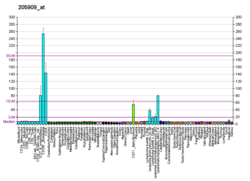
KNOWPIA
WELCOME TO KNOWPIA
Summary
DNA polymerase epsilon subunit 2 is an enzyme that in humans is encoded by the POLE2 gene.[5][6][7]
| POLE2 | |||||||||||||||||||||||||||||||||||||||||||||||||||
|---|---|---|---|---|---|---|---|---|---|---|---|---|---|---|---|---|---|---|---|---|---|---|---|---|---|---|---|---|---|---|---|---|---|---|---|---|---|---|---|---|---|---|---|---|---|---|---|---|---|---|---|
| |||||||||||||||||||||||||||||||||||||||||||||||||||
| Identifiers | |||||||||||||||||||||||||||||||||||||||||||||||||||
| Aliases | POLE2, DPE2, polymerase (DNA) epsilon 2, accessory subunit, DNA polymerase epsilon 2, accessory subunit | ||||||||||||||||||||||||||||||||||||||||||||||||||
| External IDs | OMIM: 602670 MGI: 1197514 HomoloGene: 2015 GeneCards: POLE2 | ||||||||||||||||||||||||||||||||||||||||||||||||||
| |||||||||||||||||||||||||||||||||||||||||||||||||||
| |||||||||||||||||||||||||||||||||||||||||||||||||||
| |||||||||||||||||||||||||||||||||||||||||||||||||||
| |||||||||||||||||||||||||||||||||||||||||||||||||||
| |||||||||||||||||||||||||||||||||||||||||||||||||||
| Wikidata | |||||||||||||||||||||||||||||||||||||||||||||||||||
| |||||||||||||||||||||||||||||||||||||||||||||||||||
Interactions edit
References edit
- ^ a b c GRCh38: Ensembl release 89: ENSG00000100479 – Ensembl, May 2017
- ^ a b c GRCm38: Ensembl release 89: ENSMUSG00000020974 – Ensembl, May 2017
- ^ "Human PubMed Reference:". National Center for Biotechnology Information, U.S. National Library of Medicine.
- ^ "Mouse PubMed Reference:". National Center for Biotechnology Information, U.S. National Library of Medicine.
- ^ Li Y, Asahara H, Patel VS, Zhou S, Linn S (Jan 1998). "Purification, cDNA cloning, and gene mapping of the small subunit of human DNA polymerase epsilon". J Biol Chem. 272 (51): 32337–44. doi:10.1074/jbc.272.51.32337. PMID 9405441.
- ^ Jokela M, Mäkiniemi M, Lehtonen S, Szpirer C, Hellman U, Syväoja JE (Mar 1998). "The small subunits of human and mouse DNA polymerase epsilon are homologous to the second largest subunit of the yeast Saccharomyces cerevisiae DNA polymerase epsilon". Nucleic Acids Res. 26 (3): 730–4. doi:10.1093/nar/26.3.730. PMC 147316. PMID 9443964.
- ^ "Entrez Gene: POLE2 polymerase (DNA directed), epsilon 2 (p59 subunit)".
- ^ Wada M, Miyazawa H, Wang RS, Mizuno T, Sato A, Asashima M, Hanaoka F (Mar 2002). "The second largest subunit of mouse DNA polymerase epsilon, DPE2, interacts with SAP18 and recruits the Sin3 co-repressor protein to DNA". J. Biochem. 131 (3): 307–11. doi:10.1093/oxfordjournals.jbchem.a003104. PMID 11872158.
Further reading edit
- Stelzl U, Worm U, Lalowski M, Haenig C, Brembeck FH, Goehler H, Stroedicke M, Zenkner M, Schoenherr A, Koeppen S, Timm J, Mintzlaff S, Abraham C, Bock N, Kietzmann S, Goedde A, Toksöz E, Droege A, Krobitsch S, Korn B, Birchmeier W, Lehrach H, Wanker EE (2005). "A human protein-protein interaction network: a resource for annotating the proteome". Cell. 122 (6): 957–68. doi:10.1016/j.cell.2005.08.029. hdl:11858/00-001M-0000-0010-8592-0. PMID 16169070. S2CID 8235923.
- Post SM, Tomkinson AE, Lee EY (2003). "The human checkpoint Rad protein Rad17 is chromatin-associated throughout the cell cycle, localizes to DNA replication sites, and interacts with DNA polymerase ε". Nucleic Acids Res. 31 (19): 5568–75. doi:10.1093/nar/gkg765. PMC 206465. PMID 14500819.
- Wada M, Miyazawa H, Wang RS, Mizuno T, Sato A, Asashima M, Hanaoka F (2002). "The second largest subunit of mouse DNA polymerase epsilon, DPE2, interacts with SAP18 and recruits the Sin3 co-repressor protein to DNA". J. Biochem. 131 (3): 307–11. doi:10.1093/oxfordjournals.jbchem.a003104. PMID 11872158.
- Huang D, Jokela M, Tuusa J, Skog S, Poikonen K, Syväoja JE (2001). "E2F mediates induction of the Sp1-controlled promoter of the human DNA polymerase ɛ B-subunit gene POLE2". Nucleic Acids Res. 29 (13): 2810–21. doi:10.1093/nar/29.13.2810. PMC 55767. PMID 11433027.
- Li Y, Pursell ZF, Linn S (2000). "Identification and cloning of two histone fold motif-containing subunits of HeLa DNA polymerase epsilon". J. Biol. Chem. 275 (30): 23247–52. doi:10.1074/jbc.M002548200. PMID 10801849.
External links edit
- PDBe-KB provides an overview of all the structure information available in the PDB for Human DNA polymerase epsilon subunit 2 (POLE2)







